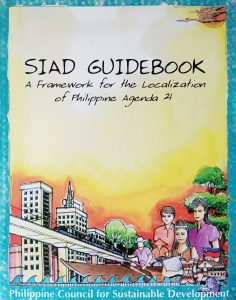SIAD 3.0 or the Sustainable Integrated Area Development 3.0 was created from the technological and societal innovation of SIAD 1.0 and SIAD 2.0. With the help of its partner agencies, SEA, Inc. continues to demonstrate how to advance ISD or Integrated Sustainable Development in the barangay and town level by the coming together of the threefolding spheres in the society: the business, the civil society and the government.
The SIAD3.0 covers five (5) municipalities in the provinces of Iloilo and Antique namely: The Municipality of Ajuy, the Municipality of Lambunao, the Municipality of Cabatuan, the Municipality of Zarraga and the Municipality of Belison.
The simplest way to understand SIAD is to take a look at the three words that describe it. SIAD is development that is sustainable, integrated, and area-based.
SUSTAINABLE– SIAD is long term, continuous and inter-generational. It strives for a sound and viable economy through the mobilization of local skills, talents, capital, and culture and utilizing local resources in a manner that is determined by the community itself. Because of threefolding, SIAD’s participatory approaches builds unity and bind people together in a common goal and vision. It also builds a socially cohesive society, one that is conducive, among others, for appropriate investment flows that have the potential to reduce and, ultimately, eradicate poverty in the area. SIAD is also ecologically sustainable because broad-based participation necessarily means that SIAD will advance community-based approaches to the management of local resources and the use of appropriate technologies. Participation of the community also means that SIAD projects tend to be culturally sustainable and gender sensitive. SIAD builds strength and sustainability in the governance process because threefolding partnerships lead to a greater support for and the legitimacy of political processes. Sustainability also refers to both sustaining the development initiative (process or method) itself and sustaining the gains (results and outcomes) of such development interventions.
INTEGRATED – SIAD seeks to mirror, in idea and practice, the wide-ranging vision, framework, principles, parameters, and strategies of PA21.SIAD harmonizes the potentially conflicting needs of local communities by encouraging the participation of as many local interests/stakeholders as possible as well as showing their inner connections with the wide-ranging objectives of sustainable development. SIAD can easily integrate the various initiatives and understand how the viability of non-economic factors significantly influences the viability of economic approaches.
AREA-BASED– SIAD situates the development of a specific area. An area could be a geopolitical-based or ecosystems-based. Thus, it could be an LGU (barangay, town, city, or province) or a cluster of LGUs within a broader defined area (e.g. an ancestral domain, protected area, a watershed area, etc.). In so doing, SIAD can have a realistic overview of the possible challenges and opportunities that exist in an area. In terms of poverty eradication, SIAD encourages area cooperation, thus facilitating convergence- the linkage of resources, institutions, ideas and projects, all within a clearly defined areas.

